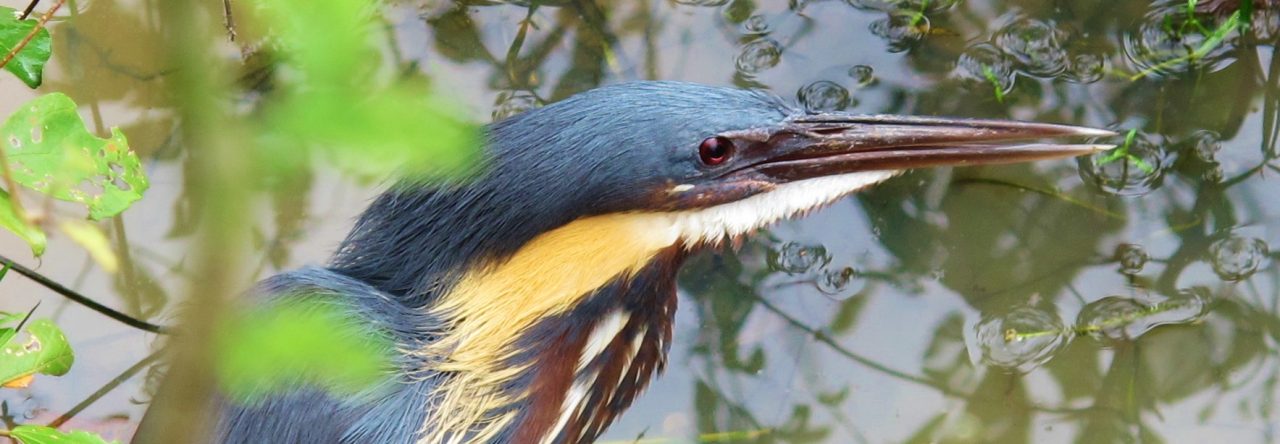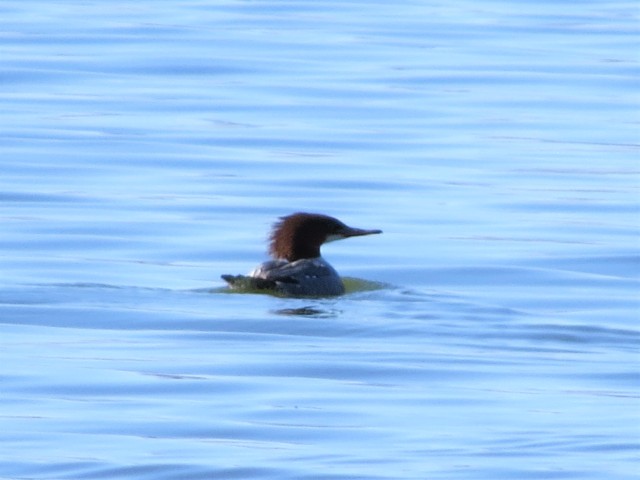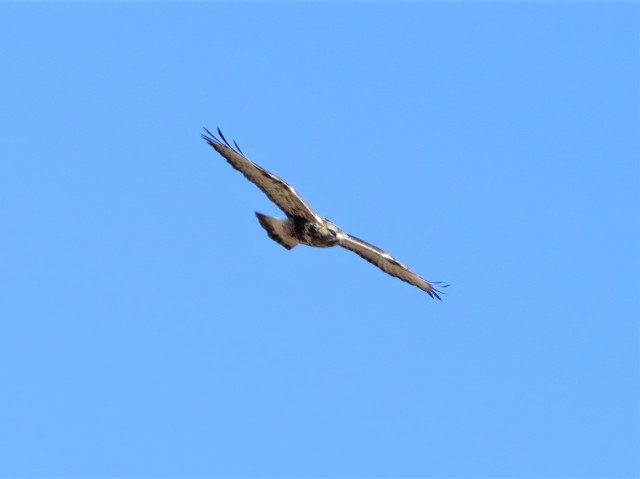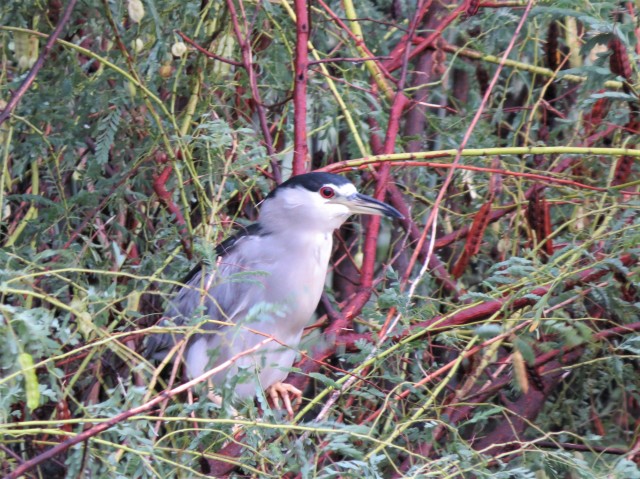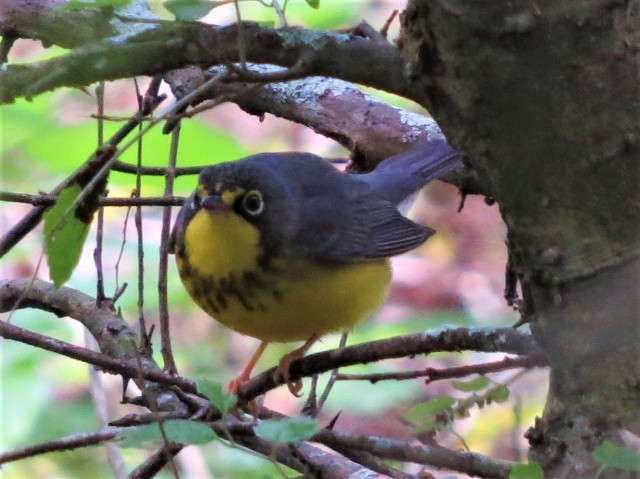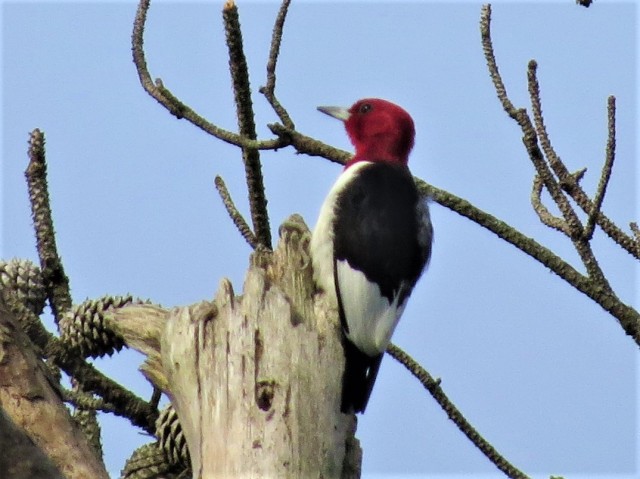
Most birders keep lists of the birds they see. World lists, year lists, country lists, county lists, backyard lists – even lists of birds seen while doing something else. Those of us who enter all our bird sightings in eBird find that our lists are effortlessly compiled: eBird automatically keeps meticulous statistics for all the birds we see. With a couple of clicks of the mouse, I can find out which birds I have seen in Harris County this year; how many European Starlings I saw in my backyard in 2015 – and even how I rank against other birders for a particular patch, state, country or year.
With reference to the last category, I must admit to having been fairly obsessive with following the eBird rankings in 2017. I finished the year with 424 species on my Texas year list (although eBird lists me at 425 thanks to an escaped Orange-cheeked Waxbill which I do not count!). This put me at 10th for the year in Texas. Considering that most – or even perhaps all – of the nine birders ahead of me don’t have full time jobs, I feel pretty pleased with my total for the year.
Being a statistics nerd, I used eBird’s extensive records of my birding to compile a full report. The results are below:
Total number of species recorded: 424
This is the total number of species I saw and/or heard within the state of Texas in 2017, including established introduced species.
Total number of species seen: 423
The only bird I heard, but didn’t actually put my eyes on, during 2017 was Northern Beardless-Tyrannulet. Many birders submit “heard-only” owls and rails on their eBird checklists, but I generally prefer not to include these.
Total number of species seen, excluding non-native species: 410
Some birds live and breed in Texas, but are not naturally occurring. They are usually here as a result of human introductions. These range from the common and ubiquitous House Sparrow and European Starling, to several species of rare parrots in Brownsville. Even after removing these birds, I am still on well over 400 for the year.
Introduced species I saw in 2017 that I excluded from this list:
Egyptian Goose
Ring-necked Pheasant
Feral Pigeon
Eurasian Collared-Dove
Monk Parakeet
Red-crowned Parrot
Red-lored Parrot
White-fronted Parrot
Yellow-headed Parrot
Red-vented Bulbul
European Starling
House Sparrow
Scaly-breasted Munia
I do not enter obviously feral species such as Indian Peafowl, domestic-type Mallard, and Muscovy Duck on my eBird checklists.
There are several rare formerly naturally-occurring species which became extinct in the wild in Texas, and which have subsequently been reintroduced (Greater Prairie-Chicken and Aplomado Falcon). These would also have appeared on the “introductions” list above, had I seen them during 2017.
Total number of complete eBird checklists submitted: 328
This number excludes incomplete checklists (for example, when I recorded a single bird species incidentally while driving by). My total number of checklists including incomplete ones is in excess of 350.
Total number of counties birded: 75
There are 254 counties in Texas so this might not sound like much, but Texas is a very, very big place!
My birding in 2017 was concentrated in three main areas: Houston and the upper Gulf coast, the San Antonio/Austin corridor (where I spent many of my weekends), and to a lesser extent the Lower Rio Grande Valley. During the year, I made two long trips to West Texas, one in late spring and one in winter. I also made a short winter visit to the Panhandle.
Top ten counties in 2017:
The number in brackets is the number of bird species I saw in each county during the year:
1. Galveston (173)
2. Chambers (145)
3. Harris (141)
4. Jefferson (133)
5. Bexar (129)
6. Brazoria (124)
7. Comal (122)
8. Hidalgo (121)
9. Travis (92)
10. Cameron (86)
Finally, I was able to compile data from eBird showing how many times I saw each bird species during the year. To be precise, this list shows how many checklists I recorded each species on in 2017. The data needs to be taken with a pinch of salt, as I didn’t bird scientifically. For example, I birded one site in Harris and another in Comal many times during the year. Northern Cardinals are very common at both locations and I recorded them on every checklist from these two sites, which is one of the reasons why the number of Cardinal sightings is high. If I had regularly birded a mudflat instead, where Cardinals are absent, I would have recorded Cardinals on fewer checklists but (for example) Western Sandpipers on a lot more.
Also, I was year listing, which means that many target species were spotted only a small number of times. For example, Red-cockaded Woodpecker is easy to find at W G Jones State Forest near Houston, but I only recorded this species on one checklist because I only visited the site on one occasion. As soon as the bird was safely on my year list, I didn’t bother going back.
The list arranged in taxonomic order:
Black-bellied Whistling-Duck 29
Fulvous Whistling-Duck 7
Snow Goose 7
Ross’s Goose 1
Greater White-fronted Goose 6
Cackling Goose 1
Canada Goose 2
Egyptian Goose 18
Wood Duck 18
Blue-winged Teal 33
Cinnamon Teal 5
Northern Shoveler 27
Gadwall 33
American Wigeon 9
Mallard 12
Mottled Duck 27
Northern Pintail 13
Green-winged Teal 18
Canvasback 4
Redhead 7
Ring-necked Duck 15
Greater Scaup 1
Lesser Scaup 16
Long-tailed Duck 1
Bufflehead 8
Common Goldeneye 2
Hooded Merganser 2
Common Merganser 1
Red-breasted Merganser 9
Ruddy Duck 15
Plain Chachalaca 4
Northern Bobwhite 1
Scaled Quail 10
Gambel’s Quail 1
Ring-necked Pheasant 2
Wild Turkey 6
Common Loon 6
Least Grebe 9
Pied-billed Grebe 40
Horned Grebe 1
Eared Grebe 4
Western Grebe 1
Clark’s Grebe 2
Wood Stork 2
Magnificent Frigatebird 3
Brown Booby 1
Neotropic Cormorant 49
Double-crested Cormorant 44
Anhinga 12
American White Pelican 21
Brown Pelican 47
American Bittern 6
Least Bittern 3
Great Blue Heron 83
Great Egret 83
Snowy Egret 63
Little Blue Heron 38
Tricolored Heron 31
Reddish Egret 16
Cattle Egret 35
Green Heron 25
Black-crowned Night-Heron 13
Yellow-crowned Night-Heron 14
White Ibis 53
Glossy Ibis 2
White-faced Ibis 25
Roseate Spoonbill 32
Black Vulture 88
Turkey Vulture 126
Osprey 26
White-tailed Kite 14
Swallow-tailed Kite 1
Golden Eagle 2
Mississippi Kite 11
Northern Harrier 45
Sharp-shinned Hawk 6
Cooper’s Hawk 29
Bald Eagle 6
Common Black Hawk 1
Harris’s Hawk 10
White-tailed Hawk 14
Gray Hawk 1
Red-shouldered Hawk 39
Broad-winged Hawk 5
Swainson’s Hawk 6
Zone-tailed Hawk 3
Red-tailed Hawk 51
Rough-legged Hawk 2
Ferruginous Hawk 4
King Rail 2
Clapper Rail 4
Sora 2
Purple Gallinule 6
Common Gallinule 23
American Coot 43
Sandhill Crane 10
Whooping Crane 2
Black-necked Stilt 31
American Avocet 12
American Oystercatcher 4
Black-bellied Plover 17
American Golden-Plover 3
Snowy Plover 4
Wilson’s Plover 4
Semipalmated Plover 6
Piping Plover 7
Killdeer 75
Mountain Plover 4
Upland Sandpiper 4
Whimbrel 6
Long-billed Curlew 10
Hudsonian Godwit 1
Marbled Godwit 7
Ruddy Turnstone 15
Red Knot 2
Stilt Sandpiper 11
Sanderling 19
Dunlin 16
Baird’s Sandpiper 1
Least Sandpiper 30
White-rumped Sandpiper 5
Buff-breasted Sandpiper 2
Pectoral Sandpiper 9
Semipalmated Sandpiper 14
Western Sandpiper 13
Short-billed Dowitcher 8
Long-billed Dowitcher 12
American Woodcock 1
Wilson’s Snipe 8
Wilson’s Phalarope 5
Spotted Sandpiper 25
Solitary Sandpiper 4
Greater Yellowlegs 20
Willet 32
Lesser Yellowlegs 29
Sabine’s Gull 1
Bonaparte’s Gull 2
Laughing Gull 61
Franklin’s Gull 2
Ring-billed Gull 34
Herring Gull 17
Lesser Black-backed Gull 5
Least Tern 8
Gull-billed Tern 5
Caspian Tern 13
Black Tern 12
Common Tern 3
Forster’s Tern 38
Royal Tern 30
Sandwich Tern 11
Elegant Tern 1
Black Skimmer 14
Rock Pigeon 30
Red-billed Pigeon 1
Eurasian Collared-Dove 22
Inca Dove 16
Common Ground-Dove 7
White-tipped Dove 5
White-winged Dove 112
Mourning Dove 135
Groove-billed Ani 2
Greater Roadrunner 15
Yellow-billed Cuckoo 14
Barn Owl 1
Eastern Screech-Owl 5
Great Horned Owl 6
Burrowing Owl 5
Barred Owl 2
Lesser Nighthawk 3
Common Nighthawk 14
Common Pauraque 2
Chuck-will’s-widow 2
Eastern Whip-poor-will 1
Chimney Swift 39
White-throated Swift 3
Blue-throated Hummingbird 1
Lucifer Hummingbird 1
Ruby-throated Hummingbird 17
Black-chinned Hummingbird 24
Anna’s Hummingbird 1
Broad-tailed Hummingbird 1
Rufous Hummingbird 1
Broad-billed Hummingbird 1
Buff-bellied Hummingbird 2
Ringed Kingfisher 1
Belted Kingfisher 32
Green Kingfisher 5
Red-headed Woodpecker 2
Acorn Woodpecker 6
Golden-fronted Woodpecker 51
Red-bellied Woodpecker 54
Yellow-bellied Sapsucker 17
Ladder-backed Woodpecker 40
Downy Woodpecker 82
Red-cockaded Woodpecker 1
Northern Flicker 15
Pileated Woodpecker 32
Crested Caracara 59
American Kestrel 63
Merlin 5
Peregrine Falcon 8
Prairie Falcon 2
Monk Parakeet 3
Red-crowned Parrot 1
Red-lored Parrot 1
Yellow-headed Parrot 1
White-fronted Parrot 1
Northern Beardless-Tyrannulet 1
Olive-sided Flycatcher 3
Western Wood-Pewee 6
Eastern Wood-Pewee 14
Yellow-bellied Flycatcher 3
Acadian Flycatcher 6
Willow Flycatcher 1
Least Flycatcher 4
Gray Flycatcher 1
Cordilleran Flycatcher 1
Black Phoebe 2
Eastern Phoebe 81
Say’s Phoebe 14
Vermilion Flycatcher 17
Ash-throated Flycatcher 11
Great Crested Flycatcher 26
Brown-crested Flycatcher 4
Great Kiskadee 8
Tropical Kingbird 2
Couch’s Kingbird 13
Cassin’s Kingbird 5
Western Kingbird 12
Eastern Kingbird 20
Scissor-tailed Flycatcher 49
Loggerhead Shrike 76
Black-capped Vireo 1
White-eyed Vireo 42
Bell’s Vireo 10
Gray Vireo 1
Hutton’s Vireo 2
Yellow-throated Vireo 5
Blue-headed Vireo 21
Plumbeous Vireo 1
Philadelphia Vireo 1
Warbling Vireo 4
Red-eyed Vireo 5
Black-whiskered Vireo 1
Green Jay 8
Steller’s Jay 1
Blue Jay 80
Woodhouse’s Scrub-Jay 6
Mexican Jay 3
American Crow 35
Tamaulipas Crow 1
Fish Crow 2
Chihuahuan Raven 5
Common Raven 13
Horned Lark 16
Northern Rough-winged Swallow 17
Purple Martin 31
Tree Swallow 19
Violet-green Swallow 1
Bank Swallow 4
Barn Swallow 82
Cliff Swallow 22
Cave Swallow 17
Carolina Chickadee 94
Mountain Chickadee 2
Juniper Titmouse 1
Tufted Titmouse 16
Black-crested Titmouse 46
Verdin 15
Bushtit 3
Red-breasted Nuthatch 2
White-breasted Nuthatch 2
Brown-headed Nuthatch 2
Brown Creeper 2
Rock Wren 3
Canyon Wren 4
House Wren 26
Winter Wren 2
Sedge Wren 11
Marsh Wren 10
Carolina Wren 104
Bewick’s Wren 38
Cactus Wren 6
Blue-gray Gnatcatcher 80
Black-tailed Gnatcatcher 6
Red-vented Bulbul 1
Golden-crowned Kinglet 3
Ruby-crowned Kinglet 85
Eastern Bluebird 16
Western Bluebird 3
Mountain Bluebird 2
Veery 5
Gray-cheeked Thrush 4
Swainson’s Thrush 19
Hermit Thrush 21
Wood Thrush 11
Clay-colored Thrush 4
American Robin 73
Gray Catbird 15
Curve-billed Thrasher 8
Brown Thrasher 12
Long-billed Thrasher 7
Crissal Thrasher 1
Sage Thrasher 1
Northern Mockingbird 149
European Starling 81
American Pipit 15
Sprague’s Pipit 2
Cedar Waxwing 37
Phainopepla 2
Lapland Longspur 4
McCown’s Longspur 1
Ovenbird 12
Worm-eating Warbler 8
Louisiana Waterthrush 5
Northern Waterthrush 10
Golden-winged Warbler 5
Blue-winged Warbler 5
Black-and-white Warbler 21
Prothonotary Warbler 3
Swainson’s Warbler 2
Tennessee Warbler 4
Orange-crowned Warbler 69
Colima Warbler 1
Nashville Warbler 5
MacGillivray’s Warbler 4
Mourning Warbler 1
Kentucky Warbler 4
Common Yellowthroat 34
Hooded Warbler 20
American Redstart 12
Cape May Warbler 3
Cerulean Warbler 1
Northern Parula 11
Tropical Parula 1
Magnolia Warbler 9
Bay-breasted Warbler 1
Blackburnian Warbler 3
Yellow Warbler 13
Chestnut-sided Warbler 5
Blackpoll Warbler 1
Palm Warbler 5
Pine Warbler 13
Yellow-rumped Warbler 80
Yellow-throated Warbler 11
Prairie Warbler 1
Golden-cheeked Warbler 1
Black-throated Green Warbler 8
Canada Warbler 9
Wilson’s Warbler 26
White-collared Seedeater 1
Botteri’s Sparrow 1
Cassin’s Sparrow 2
Bachman’s Sparrow 1
Grasshopper Sparrow 6
Henslow’s Sparrow 1
LeConte’s Sparrow 2
Nelson’s Sparrow 1
Seaside Sparrow 2
Olive Sparrow 9
American Tree Sparrow 2
Chipping Sparrow 23
Clay-colored Sparrow 1
Black-chinned Sparrow 2
Field Sparrow 11
Brewer’s Sparrow 3
Black-throated Sparrow 12
Lark Sparrow 16
Lark Bunting 2
Fox Sparrow 5
Dark-eyed Junco 10
White-crowned Sparrow 32
Golden-crowned Sparrow 1
Harris’s Sparrow 5
White-throated Sparrow 24
Sagebrush Sparrow 2
Vesper Sparrow 9
Savannah Sparrow 46
Song Sparrow 19
Lincoln’s Sparrow 40
Swamp Sparrow 13
Canyon Towhee 6
Rufous-crowned Sparrow 9
Green-tailed Towhee 4
Spotted Towhee 17
Eastern Towhee 1
Yellow-breasted Chat 9
Hepatic Tanager 2
Summer Tanager 16
Scarlet Tanager 5
Northern Cardinal 184
Pyrrhuloxia 14
Rose-breasted Grosbeak 5
Black-headed Grosbeak 5
Blue Grosbeak 17
Indigo Bunting 11
Varied Bunting 3
Painted Bunting 18
Dickcissel 8
Yellow-headed Blackbird 1
Western Meadowlark 16
Eastern Meadowlark 42
Orchard Oriole 19
Hooded Oriole 2
Bullock’s Oriole 2
Altamira Oriole 2
Audubon’s Oriole 1
Baltimore Oriole 7
Scott’s Oriole 4
Red-winged Blackbird 77
Bronzed Cowbird 5
Brown-headed Cowbird 46
Rusty Blackbird 1
Brewer’s Blackbird 19
Common Grackle 19
Boat-tailed Grackle 16
Great-tailed Grackle 128
House Finch 52
Cassin’s Finch 1
Pine Siskin 6
Lesser Goldfinch 36
American Goldfinch 14
House Sparrow 49
Scaly-breasted Munia 2
…. and here it is arranged in order of species abundance:
Northern Cardinal 184
Northern Mockingbird 149
Mourning Dove 135
Great-tailed Grackle 128
Turkey Vulture 126
White-winged Dove 112
Carolina Wren 104
Carolina Chickadee 94
Black Vulture 88
Ruby-crowned Kinglet 85
Great Blue Heron 83
Great Egret 83
Downy Woodpecker 82
Barn Swallow 82
Eastern Phoebe 81
European Starling 81
Blue Jay 80
Blue-gray Gnatcatcher 80
Yellow-rumped Warbler 80
Red-winged Blackbird 77
Loggerhead Shrike 76
Killdeer 75
American Robin 73
Orange-crowned Warbler 69
Snowy Egret 63
American Kestrel 63
Laughing Gull 61
Crested Caracara 59
Red-bellied Woodpecker 54
White Ibis 53
House Finch 52
Red-tailed Hawk 51
Golden-fronted Woodpecker 51
Neotropic Cormorant 49
Scissor-tailed Flycatcher 49
House Sparrow 49
Brown Pelican 47
Black-crested Titmouse 46
Savannah Sparrow 46
Brown-headed Cowbird 46
Northern Harrier 45
Double-crested Cormorant 44
American Coot 43
White-eyed Vireo 42
Eastern Meadowlark 42
Pied-billed Grebe 40
Ladder-backed Woodpecker 40
Lincoln’s Sparrow 40
Red-shouldered Hawk 39
Chimney Swift 39
Little Blue Heron 38
Forster’s Tern 38
Bewick’s Wren 38
Cedar Waxwing 37
Lesser Goldfinch 36
Cattle Egret 35
American Crow 35
Ring-billed Gull 34
Common Yellowthroat 34
Blue-winged Teal 33
Gadwall 33
Roseate Spoonbill 32
Willet 32
Belted Kingfisher 32
Pileated Woodpecker 32
White-crowned Sparrow 32
Tricolored Heron 31
Black-necked Stilt 31
Purple Martin 31
Least Sandpiper 30
Royal Tern 30
Rock Pigeon 30
Black-bellied Whistling-Duck 29
Cooper’s Hawk 29
Lesser Yellowlegs 29
Northern Shoveler 27
Mottled Duck 27
Osprey 26
Great Crested Flycatcher 26
House Wren 26
Wilson’s Warbler 26
Green Heron 25
White-faced Ibis 25
Spotted Sandpiper 25
Black-chinned Hummingbird 24
White-throated Sparrow 24
Common Gallinule 23
Chipping Sparrow 23
Eurasian Collared-Dove 22
Cliff Swallow 22
American White Pelican 21
Blue-headed Vireo 21
Hermit Thrush 21
Black-and-white Warbler 21
Greater Yellowlegs 20
Eastern Kingbird 20
Hooded Warbler 20
Sanderling 19
Tree Swallow 19
Swainson’s Thrush 19
Song Sparrow 19
Orchard Oriole 19
Brewer’s Blackbird 19
Common Grackle 19
Egyptian Goose 18
Wood Duck 18
Green-winged Teal 18
Painted Bunting 18
Black-bellied Plover 17
Herring Gull 17
Ruby-throated Hummingbird 17
Yellow-bellied Sapsucker 17
Vermilion Flycatcher 17
Northern Rough-winged Swallow 17
Cave Swallow 17
Spotted Towhee 17
Blue Grosbeak 17
Lesser Scaup 16
Reddish Egret 16
Dunlin 16
Inca Dove 16
Horned Lark 16
Tufted Titmouse 16
Eastern Bluebird 16
Lark Sparrow 16
Summer Tanager 16
Western Meadowlark 16
Boat-tailed Grackle 16
Ring-necked Duck 15
Ruddy Duck 15
Ruddy Turnstone 15
Greater Roadrunner 15
Northern Flicker 15
Verdin 15
Gray Catbird 15
American Pipit 15
Yellow-crowned Night-Heron 14
White-tailed Kite 14
White-tailed Hawk 14
Semipalmated Sandpiper 14
Black Skimmer 14
Yellow-billed Cuckoo 14
Common Nighthawk 14
Eastern Wood-Pewee 14
Say’s Phoebe 14
Pyrrhuloxia 14
American Goldfinch 14
Northern Pintail 13
Black-crowned Night-Heron 13
Western Sandpiper 13
Caspian Tern 13
Couch’s Kingbird 13
Common Raven 13
Yellow Warbler 13
Pine Warbler 13
Swamp Sparrow 13
Mallard 12
Anhinga 12
American Avocet 12
Long-billed Dowitcher 12
Black Tern 12
Western Kingbird 12
Brown Thrasher 12
Ovenbird 12
American Redstart 12
Black-throated Sparrow 12
Mississippi Kite 11
Stilt Sandpiper 11
Sandwich Tern 11
Ash-throated Flycatcher 11
Sedge Wren 11
Wood Thrush 11
Northern Parula 11
Yellow-throated Warbler 11
Field Sparrow 11
Indigo Bunting 11
Scaled Quail 10
Harris’s Hawk 10
Sandhill Crane 10
Long-billed Curlew 10
Bell’s Vireo 10
Marsh Wren 10
Northern Waterthrush 10
Dark-eyed Junco 10
American Wigeon 9
Red-breasted Merganser 9
Least Grebe 9
Pectoral Sandpiper 9
Magnolia Warbler 9
Canada Warbler 9
Olive Sparrow 9
Vesper Sparrow 9
Rufous-crowned Sparrow 9
Yellow-breasted Chat 9
Bufflehead 8
Short-billed Dowitcher 8
Wilson’s Snipe 8
Least Tern 8
Peregrine Falcon 8
Great Kiskadee 8
Green Jay 8
Curve-billed Thrasher 8
Worm-eating Warbler 8
Black-throated Green Warbler 8
Dickcissel 8
Fulvous Whistling-Duck 7
Snow Goose 7
Redhead 7
Piping Plover 7
Marbled Godwit 7
Common Ground-Dove 7
Long-billed Thrasher 7
Baltimore Oriole 7
Greater White-fronted Goose 6
Wild Turkey 6
Common Loon 6
American Bittern 6
Sharp-shinned Hawk 6
Bald Eagle 6
Swainson’s Hawk 6
Purple Gallinule 6
Semipalmated Plover 6
Whimbrel 6
Great Horned Owl 6
Acorn Woodpecker 6
Western Wood-Pewee 6
Acadian Flycatcher 6
Woodhouse’s Scrub-Jay 6
Cactus Wren 6
Black-tailed Gnatcatcher 6
Grasshopper Sparrow 6
Canyon Towhee 6
Pine Siskin 6
Cinnamon Teal 5
Broad-winged Hawk 5
White-rumped Sandpiper 5
Wilson’s Phalarope 5
Lesser Black-backed Gull 5
Gull-billed Tern 5
White-tipped Dove 5
Eastern Screech-Owl 5
Burrowing Owl 5
Green Kingfisher 5
Merlin 5
Cassin’s Kingbird 5
Yellow-throated Vireo 5
Red-eyed Vireo 5
Chihuahuan Raven 5
Veery 5
Louisiana Waterthrush 5
Golden-winged Warbler 5
Blue-winged Warbler 5
Nashville Warbler 5
Chestnut-sided Warbler 5
Palm Warbler 5
Fox Sparrow 5
Harris’s Sparrow 5
Scarlet Tanager 5
Rose-breasted Grosbeak 5
Black-headed Grosbeak 5
Bronzed Cowbird 5
Canvasback 4
Plain Chachalaca 4
Eared Grebe 4
Ferruginous Hawk 4
Clapper Rail 4
American Oystercatcher 4
Snowy Plover 4
Wilson’s Plover 4
Mountain Plover 4
Upland Sandpiper 4
Solitary Sandpiper 4
Least Flycatcher 4
Brown-crested Flycatcher 4
Warbling Vireo 4
Bank Swallow 4
Canyon Wren 4
Gray-cheeked Thrush 4
Clay-colored Thrush 4
Lapland Longspur 4
Tennessee Warbler 4
MacGillivray’s Warbler 4
Kentucky Warbler 4
Green-tailed Towhee 4
Scott’s Oriole 4
Magnificent Frigatebird 3
Least Bittern 3
Zone-tailed Hawk 3
American Golden-Plover 3
Common Tern 3
Lesser Nighthawk 3
White-throated Swift 3
Monk Parakeet 3
Olive-sided Flycatcher 3
Yellow-bellied Flycatcher 3
Mexican Jay 3
Bushtit 3
Rock Wren 3
Golden-crowned Kinglet 3
Western Bluebird 3
Prothonotary Warbler 3
Cape May Warbler 3
Blackburnian Warbler 3
Brewer’s Sparrow 3
Varied Bunting 3
Canada Goose 2
Common Goldeneye 2
Hooded Merganser 2
Ring-necked Pheasant 2
Clark’s Grebe 2
Wood Stork 2
Glossy Ibis 2
Golden Eagle 2
Rough-legged Hawk 2
King Rail 2
Sora 2
Whooping Crane 2
Red Knot 2
Buff-breasted Sandpiper 2
Bonaparte’s Gull 2
Franklin’s Gull 2
Groove-billed Ani 2
Barred Owl 2
Common Pauraque 2
Chuck-will’s-widow 2
Buff-bellied Hummingbird 2
Red-headed Woodpecker 2
Prairie Falcon 2
Black Phoebe 2
Tropical Kingbird 2
Hutton’s Vireo 2
Fish Crow 2
Mountain Chickadee 2
Red-breasted Nuthatch 2
White-breasted Nuthatch 2
Brown-headed Nuthatch 2
Brown Creeper 2
Winter Wren 2
Mountain Bluebird 2
Sprague’s Pipit 2
Phainopepla 2
Swainson’s Warbler 2
Cassin’s Sparrow 2
LeConte’s Sparrow 2
Seaside Sparrow 2
American Tree Sparrow 2
Black-chinned Sparrow 2
Lark Bunting 2
Sagebrush Sparrow 2
Hepatic Tanager 2
Hooded Oriole 2
Bullock’s Oriole 2
Altamira Oriole 2
Orange-cheeked Waxbill 2
Scaly-breasted Munia 2
Ross’s Goose 1
Cackling Goose 1
Greater Scaup 1
Long-tailed Duck 1
Common Merganser 1
Northern Bobwhite 1
Gambel’s Quail 1
Horned Grebe 1
Western Grebe 1
Brown Booby 1
Swallow-tailed Kite 1
Common Black Hawk 1
Gray Hawk 1
Hudsonian Godwit 1
Baird’s Sandpiper 1
American Woodcock 1
Sabine’s Gull 1
Elegant Tern 1
Red-billed Pigeon 1
Barn Owl 1
Eastern Whip-poor-will 1
Blue-throated Hummingbird 1
Lucifer Hummingbird 1
Anna’s Hummingbird 1
Broad-tailed Hummingbird 1
Rufous Hummingbird 1
Broad-billed Hummingbird 1
Ringed Kingfisher 1
Red-cockaded Woodpecker 1
Red-crowned Parrot 1
Red-lored Parrot 1
Yellow-headed Parrot 1
White-fronted Parrot 1
Northern Beardless-Tyrannulet 1
Willow Flycatcher 1
Gray Flycatcher 1
Cordilleran Flycatcher 1
Black-capped Vireo 1
Gray Vireo 1
Plumbeous Vireo 1
Philadelphia Vireo 1
Black-whiskered Vireo 1
Steller’s Jay 1
Tamaulipas Crow 1
Violet-green Swallow 1
Juniper Titmouse 1
Red-vented Bulbul 1
Crissal Thrasher 1
Sage Thrasher 1
McCown’s Longspur 1
Colima Warbler 1
Mourning Warbler 1
Cerulean Warbler 1
Tropical Parula 1
Bay-breasted Warbler 1
Blackpoll Warbler 1
Prairie Warbler 1
Golden-cheeked Warbler 1
White-collared Seedeater 1
Botteri’s Sparrow 1
Bachman’s Sparrow 1
Henslow’s Sparrow 1
Nelson’s Sparrow 1
Clay-colored Sparrow 1
Golden-crowned Sparrow 1
Eastern Towhee 1
Yellow-headed Blackbird 1
Audubon’s Oriole 1
Rusty Blackbird 1
Cassin’s Finch 1
From these statistics, a visitor to Texas can get at least some idea of which birds are likely to be relatively easy or difficult to find.
I don’t feel I missed many birds during 2017. I failed to connect with a male Black-throated Blue Warbler in San Antonio early in the year, and I missed a Black-throated Gray Warbler in Brazoria County in fall. Some migrants passed me by in spring, including Alder Flycatcher, Black-billed Cuckoo, and Bobolink. My late May visit to west Texas was too late to connect with some of the migrant western birds such as Townsend’s Warbler, and I also tried twice (but failed) to see a wintering Townsend’s in Austin. I dipped Lucy’s Warbler at the Cottonwood Campground in Big Bend NP on a very windy morning.
Some species I got by the skin of my teeth: many of the migrant warblers I encountered just once (including Cerulean, Prairie, Blackpoll, Bay-breasted and Mourning). Hudsonian Godwit was a one-day wonder in spring, and my Clay-colored Sparrow at Quintana in late fall was down to pure luck after I had missed them at several much more reliable sites in central Texas. Northern Bobwhite and Audubon’s Oriole were both really tricky customers this year with just a single record of each.
Here’s to 2018 and a (slightly) more sedate Texas birding year!
